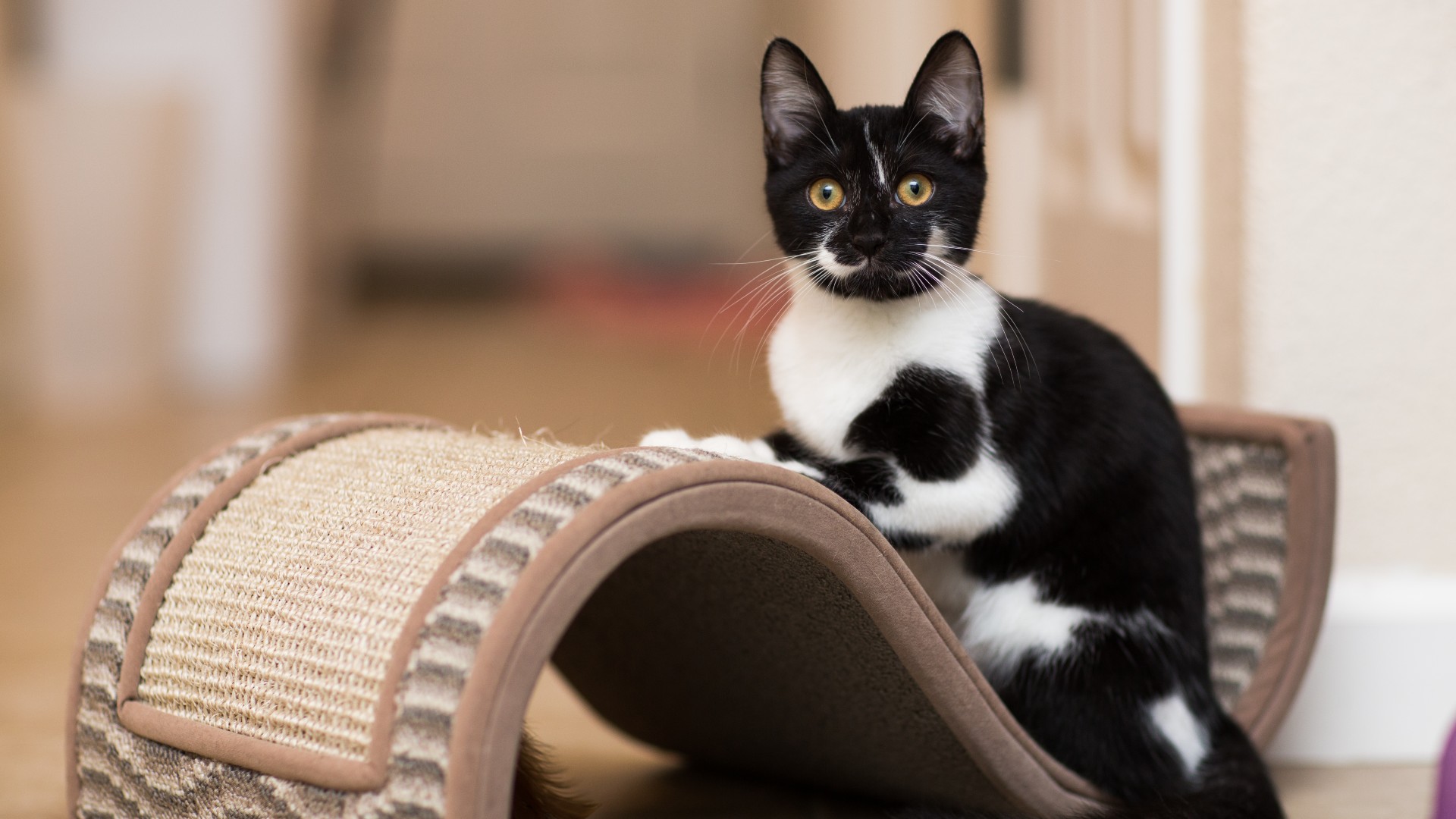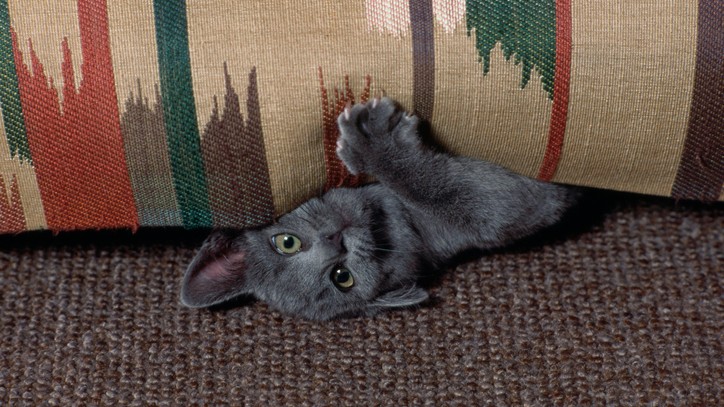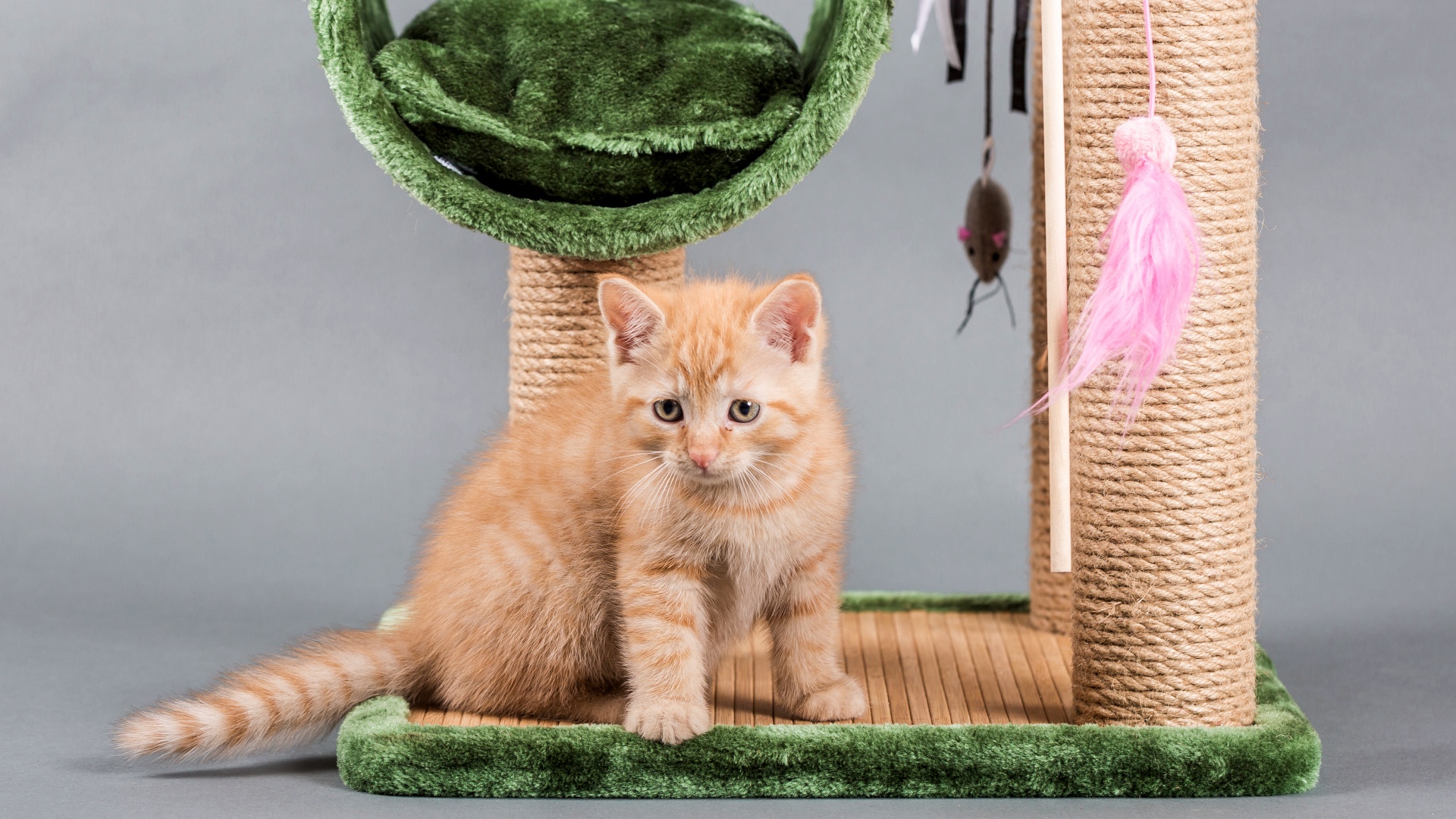How to get cats to use their scratching posts
Wondering how to get cats to use their scratching posts? Our top tips will help your kitty learn where it's okay to sharpen their claws

Scratching your head over how to get your cat to use their scratching post? If you've got a fussy feline in your household, it's common for us humans to find some of their behavior perplexing.
Getting your cat to use their new scratcher seems like it would be an easy task, but, where cats are concerned, it can actually pose somewhat of a challenge in reality. You can buy your feline all of the scratching posts available and, the likelihood is, they’ll still prefer to dig their claws into your couch instead.
Yet, training your cat to use their scratching post is an essential know-how for pet owners: not only does it satisfy your feline's natural instincts, but it keeps your cat from scratching furniture, doors, walls and everywhere in-between, saving your own sanity in the process!
From choosing the best cat scratching post for your furkid to exploring why cats scratch and how you can redirect this scratching behavior, read on to find out more about introducing and encouraging your cats to use their scratching posts… once and for all!
Why does my cat not use their scratching post?
First, you need to understand why cats scratch - and know that it's a perfectly normal feline behavior. Scratching helps cats keep their claws healthy by removing the outer layer of old claw to make way for a newer, sharper claw. Scratching also helps stretch their spine and move their muscles. It's also a way for cats to mark their territory.
If you buy a scratching post and your cat isn't using it, there could be a few reasons why. It's possible that your cat doesn't like the material - if it's very soft and covered in a carpet-like fabric, it won't feel as good as a rougher surface like sisal or cardboard. Perhaps the scratching post is too short, and they can't get that full-body stretch they're looking for.
Your cat could also have a preference for vertical or horizontal scratching, so keep that in mind. If you buy a vertical post and they ignore it, you can always get a horizontal scratcher that they might even use as a little perch!
Get the best advice, tips and top tech for your beloved Pets
The scratching post may also not be sturdy enough, which is something that will deter your cat from using it as they like to feel support. If the scratching post keeps tipping over every time your cat tries to use it, they may look for something more sturdy - like your furniture.
And don't forget the most important thing when it comes to scratching posts: location, location, location. Cats like conveniently located scratchers placed in easy-to-reach areas that are already popular spots in your home for your cat. Sometimes putting a scratcher near a piece of furniture your cat likes to scratch means they're more likely to use the scratching post instead of your couch.

How to pick the best scratching post for your cat
As with any toy you choose for your pet, you’ve got to make sure that it will appeal to them enough so that they’ll keep coming back to it. Here are some things to take into consideration whilst choosing your purr-fect scratching post:
- Type: This can be dependent on your cat’s age. For example, if they are a more mature moggy or perhaps have medical issues that restrict them from lifting their paws too high, they may prefer a scratching mat.
- Height: Since felines love to combine their scratching post with a bit of stretching, you need to make sure that it is tall enough for them to fully extend their bodies as they cling on to the top with their front paws.
- Weight: Cats love to use their scratching posts during a full body stretch. That’s why it’s so important to make sure that it is sturdy enough with a weighted base so that it won’t fall over.
- Thread: Although not the first thing that springs to mind when finding your feline’s scratching post, the thread direction is just as important as the sturdiness. Since cats scratch vertically, make sure you pick one with vertical thread as opposed to horizontal, which might not be as appealing.
If you do have more than one cat in the house, be sure to give your kitties one each - it’s all to do with the territorial marking we spoke about before - and consider getting a spare too, so that there will always be one free to use at any given time. Saves on the squabbles!
Ways to encourage your cat to use scratching post

1. Place posts in commonly used places
Most of the time, you’ll often see your feline stretching after a nice long snooze. So, the logical thing to do would be to place their scratching post next to the favorite sleeping spot. Another popular place is where they exit and enter the house, for example, next to their cat flap.
Once you notice that your cat’s focus is solely on the scratching post, it’s time to move it to one of the suggested locations above and watch as they learn to love their new toy… and not your beloved furniture!
2. Apply a catnip-based product
If that still isn’t enough, try applying a catnip-based product on your cat’s scratching post to try to draw your feline’s attention to the item that they should be sinking their claws into. The easiest way to do this is to use loose-leaf catnip on the base and at the top of the cat scratching post.
3. Offer treats
One of the easiest ways to get your cat interested in using their scratching post is to offer an incentive and what's the most magical incentive of them all? Why, a few quality cat treats of course!
Place a treat in your hand and then get your cat to come over to the post. Once they're there, hold the treat between your fingers and keep your hand just above the top of the post. In order to get the treat your kitty will have extend their front paws up the post.
Once they're used to the post and have come to associate it with treats, you can move onto the next step. Hold your cat and move their front paws gently up and down the post to mimic the movement of scratching. Again, after doing this a few times, reward them with a treat.
You can pop a few treats around the post and up near the top to encourage them to use it in the beginning and every time you see them scratching on it, reward them with a treat and lots of praise.
4. Engage in play
Make the scratching post a super fun place to be by using it as a play area. Invest in a few of the best cat toys (feather wands are particularly brilliant) and get your kitty to chase them around and up the post. You can even dangle toys from the top and get your cat to jump up and bat them about.
Not only does putting the scratching post at the center of a good game make your furkid associate it with positive emotions, you'll also be encouraging your kitty to engage with the post as they'll frequently come into contact with it while trying to get their toys.
Encouraging kittens to start using a scratching post for the first time

So you've just brought your new kitten home and all of a sudden you turn around to spot that the corner of your lovely couch has been clawed to shreds - yikes! If your first reaction was to tell your kitten off, we don't blame you, after all, furniture doesn't come cheap.
However, like with us humans, our young feline friends learn best when they're praised for good behavior as opposed to being punished for doing something wrong. We know, it requires a lot of deep breathing, right?!
But the good news is that your kitten isn't deliberately trying to upset you, they're just doing what feels natural, which is filing down their claws and marking their territory. And there's plenty you can do to help encourage them to use a scratching post and not your couch. In addition to our recommendations above, here a few of our top kitten-specific tips:
1. Choose the right kind of scratching post: Believe it or not, some scratching posts are better suited to kittens than others. Vertical posts can be quite intimidating to a little kitty and their bodies are still small at this point, so stretching out can be difficult. Instead, opt for a horizontal post or a scratching board as these are much easier for them to use.
2. Play around with texture: Experiment with different materials to see what your kitten prefers. Your furkid may like a softer feel, in which case cardboard can be a great way to go, or if they like a harder surface, go for something like jute or sisal.
3. Location, location, location: Put your kitten's post near an area that they spend a lot of time, such as beside their bed. Having it in close proximity to where they like to sleep will ensure it's one of the first things they see when they wake up.
You'll also want to use some of the tips we mentioned earlier, including turning their scratching area into a funhouse with plenty of kitten toys and dishing out lots of praise and kitten treats.
How to get an older cat to use a scratching post
Arthritis is extremely common in cats with one study finding that 30% of cats over the age of eight will be affected by this painful condition in one form or another. Once your cat gets over the age of 12, their chances of developing arthritis goes up to a whopping 90%. That's a significant number, but thankfully there are things you can do when it comes to their scratching post that will encourage them to use it and help make life more comfortable for them.
1. Choose a sturdy structure: Finding a stable scratching post is even more important for arthritic cats as taking a tumble can cause them a lot of additional pain, so go for something that's solid enough to hold up to their weight. Your senior cat will be far more likely to use their post if they're confident it can support them.
2. Think about the style: You'll want to experiment to see whether your senior cat prefers a vertical or horizontal post. No matter their age, all cats need to scratch and stretch to exercise their muscles, and this is especially important for older cats who may not get a lot of other activity. If you find they're struggling with their vertical post, try a horizontal one that can be placed on the ground.
3. Use a non-slip mat: We recommend placing a non-slip mat under whichever scratching post you choose. This will give your kitty some extra stability and will further prevent the post from moving about.
Making your senior cat feel as safe as possible around their scratcher will build their confidence with using it. And, as with kittens and adult cats, treats are also a great incentive.
How to redirect your cat from scratching furniture
But what if they still prefer everything that isn’t their scratching post? If you find that your kitty has their eye (and their claws) on a particular piece of carpet, the edge of your furniture or even a patch of textured wallpaper, there are a number of techniques you could try.
In the first instance, you could cover the area they are currently scratching and place their specific scratching post next to it in the hopes that they will naturally transfer their attention to what they should be scratching.
Should this not turn out to be a success, another option could be to try a pheromone spray to the area you don’t want to be scratched – just be sure to check that it can be sprayed on that particular material first as you wouldn’t want to cause more damage.
We explain 'Why does my cat scratch the walls?' in this feature. Or, if your cat can't use a scratching post due to arthritis, you might want to learn about cat nail clipping.
Chloe is a freelance writer, editor, and proofreader, who has more than ten years’ experience in creating animal-focussed content. From National Geographic to Animal Planet, Chloe’s passion for creating fact-filled features all about wildlife and the environment is evident. But it’s not just wild animals that Chloe’s fascinated by. Having written more than 75 articles for PetsRadar - and having her very own four-legged friend by her side - it’s no wonder that her love of dogs (and, of course, cats) has grown exponentially.
Her website, www.chloemaywrites.com, and social media pages - @ChloeMayWrites on Instagram, Facebook, and Twitter - showcase her knowledge through daily facts and trivia tidbits. For example, did you know that snails have teeth?!

